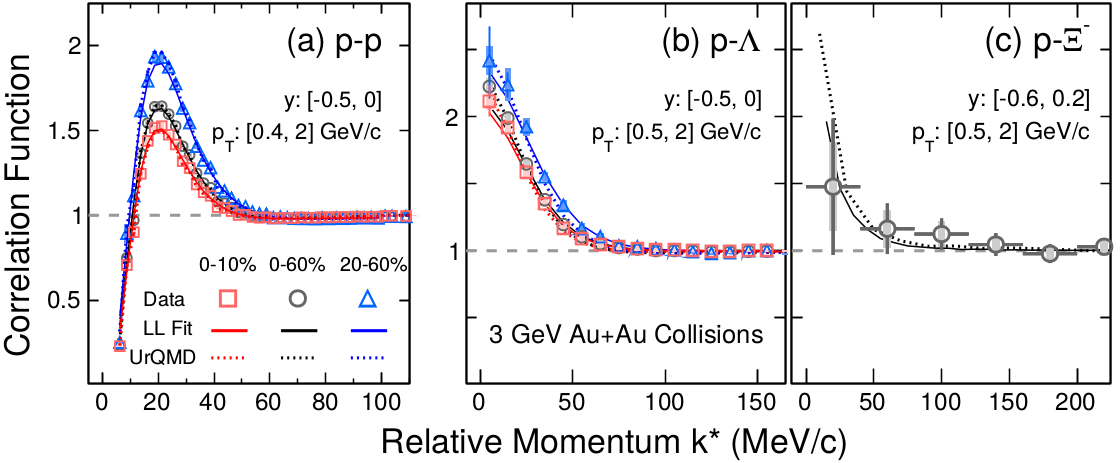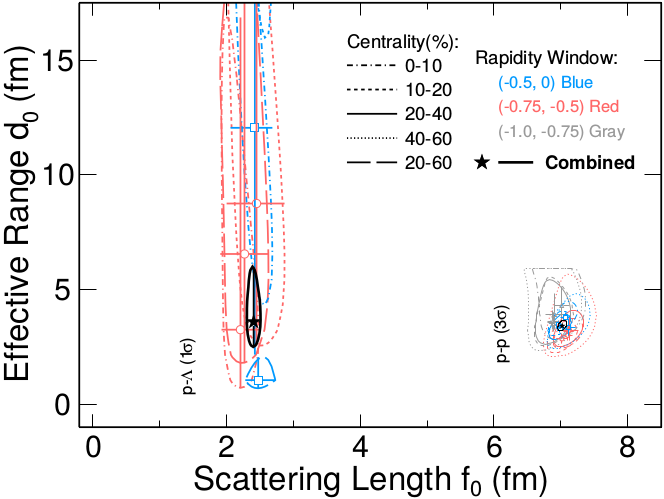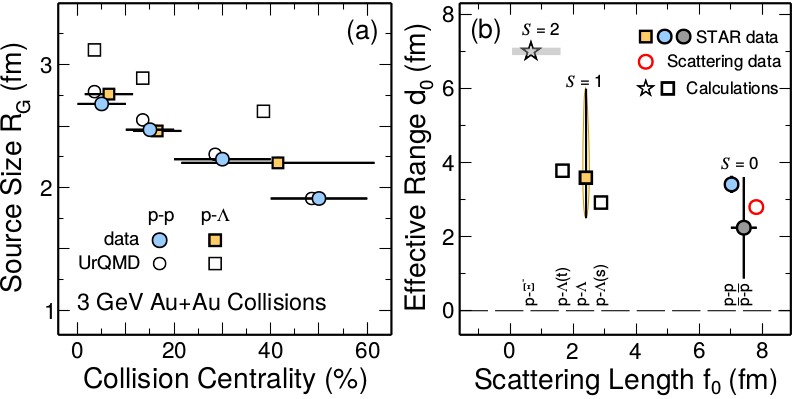Baryon-Baryon-CF-3GeV
Title: Measurements of Proton-Proton, Proton-Λ and Proton-Ξ- Correlation Functions in √s_NN= 3 GeV Au+Au Collisions at RHIC
Supplemental materials: https://drupal.star.bnl.gov/STAR/system/files/Supplemental_materials_v2.pdf
Analysis note: https://drupal.star.bnl.gov/STAR/system/files/Analysis_note_3GeV_pp_pL_pXi_v2.pdf
Responses for PWGC: https://drupal.star.bnl.gov/STAR/system/files/PWGC-response_0.pdf
Paper proposal : https://drupal.star.bnl.gov/STAR/system/files/BaryonCF_3GeV_paper_proposal_04_05.pdf
CVS codes on rcf:
Outline
- Abstract
- Motivation
- Figures
- Summary
- Supporting-materials
- Questions-in-PWGC-preview
Abstract
from two-particle correlation function measured in high-energy.
for p-p and p-Λ pairs (spin-averaged) are extracted in different collision centrality and rapidity bins.
Motivation
Figures
.png)
Fig. 1: The density distributions in transverse momentum (pT) and particle rapidity (y) for proton (a), Λ (b) and Ξ- (c) in 3.0 GeV Au+Au collisions.
A momentum cut with p < 2 GeV/c is applied in proton selection by TPC. Correlation functions are measured within the pT-y regions shown by the box.

Fig. 2: Collision centrality dependence of the correlation functions for mid-rapidity (−0.5 < y < 0) pairs of p−p (left panel)
and p−Λ (middle panel) from 3 GeV Au+Au collisions. For p−Ξ- (right panel) correlation function, only 0-60% result is available
due to the limitation in statistics. Symbols, solid lines and dashed lines represent the results from experiment, fitting results of
Lednický-Lyuboshitz (LL) model and UrQMD model calculation, respectively. Vertical bar and band on data points represent statistical and
systematic uncertainty, respectively. For p−Ξ- case, LL curve is drawn using the source-size from p−Λ pairs (0 − 60% centrality bin)
and the theoretical scattering parameters.

Fig. 3: Extracted strong interaction parameters (f0, d0) from p-p and p−Λ correlation functions in 3.0 GeV Au+Au collisions.
For p-p pairs, the resulting 3-σ contour-lines for 0-10% (dot-dashed line), 10-20% (short-dashed line), 20-40% (solid line) and
40-60% (dotted line) centrality bins and rapidity windows of [-0.5, 0] (blue), [-0.75, -0.5] (red) and [-1.0, -0.75] (gray) are shown
in the right. For p−Λ pairs, due to limited statistics, only 1-σ contours from three centrality bins 0-10 % (dot-dashed line),
10-20% (short-dashed line), 20-60% (long dashed line) and two rapidity windows [-0.5, 0] (blue) and [-0.75, -0.5] (red) are shown.
Black stars and solid lines represent the results of combined fits: while the size parameters vary as a function of collision centrality and
different rapidity windows, only one set of the strong interaction parameter (f0, d0) is extracted for given sets of correlation functions.

Fig. 4: Left panel: Mid-rapidity (-0.5 < y < 0) source size parameter, shown as a function of collision centrality, for p-p and p−Λ pairs
from = 3.0 GeV Au+Au collisions. Solid and open symbols represent the results extracted from the LL fitting to experimental data and the UrQMD
calculations, respectively. A Gaussian type single particle space distribution is assumed in the LL fit. All source-size parameters are extracted as the
RMS of pair space distribution in the pair rest frame. For data, both statistical and systematic uncertainties are included in the plot but not visible.
Right panel: Solid symbols represent the FSI parameters (f0, d0) extracted from the correlation functions. 1-sigma and 3-sigma contours are shown for
p-p and p−Λ pairs, respectively. Model results are shown as open symbols. Open star and band show the theoretical value (f0 = 0.66 fm) and
its uncertainty for p-Ξ- pair, respectively. $|S|$ (= 0, 1, 2) stands for strangeness content.
Summary
On the other hand, both values of (f0, d0) do not show any visible centrality and rapidity dependence. This is the first time a spontaneous fit is performed to extract parameters
for source size and precise parameters of the final state scatterings: (f0 = 7.02 ± 0.03 fm, d0 = 3.41 ± 0.23 fm) and (f0 = 2.41 ± 0.10 fm, d0 = 3.6 ± 1.8 fm) for the p−p and
p−Λ correlation functions, respectively. For p−Ξ− pairs, the statistics are too low to allow meaningful fit. However, using model parameters of (0.6 ≤ f0 ≤ 1.6 fm and d0 = 7.1 fm),
calculations from both UrQMD and LL models reproduce the correlation function within uncertainties. These results show a strangeness quark dependent hierarchy, i.e.,
f0(pp) > f0(pΛ) > f0(pΞ−), implying that the Y N interaction depends on the strange content and is smaller than that of NN, i.e. σY N < σNN .
The new discovery provides important information on the properties of the baryon strong interaction which is crucial for understanding the inner structure of compact star
p-p:
https://drupal.star.bnl.gov/STAR/system/files/Proton_CF_PWG_2020_1217.pdf
https://drupal.star.bnl.gov/STAR/system/files/QPT2021_Chuan_v7.pdf
https://drupal.star.bnl.gov/STAR/system/files/Proton_CF_CollaborationMeeting_Chuan_0916_v2.pdf
https://drupal.star.bnl.gov/STAR/system/files/BaryonCF_3GeV_CollaborationMeeting_Chuan_20220913.pdf
https://drupal.star.bnl.gov/STAR/system/files/Proton_CF_CollaborationMeeting_Chuan_2023_10_17.pdf
https://drupal.star.bnl.gov/STAR/system/files/pXi_CorrelationFunction_qm22poster_v5.pdf
https://drupal.star.bnl.gov/STAR/system/files/LambdaProton_CF_QinZhi_20220714.pdf
https://drupal.star.bnl.gov/STAR/system/files/pLambda_CF_Zhi_PWG20230601.pdf
https://drupal.star.bnl.gov/STAR/system/files/ProtonLambdaCF_LLFit_AuAu3GeV_QinZhi_20230826.pdf
https://drupal.star.bnl.gov/STAR/system/files/PWG_pLambdaCF_3GeV_Update_QinZhi_20240111.pdf
p-Ξ-:
https://drupal.star.bnl.gov/STAR/system/files/yingjie_20220217_3GeV_pXi.pdf
https://drupal.star.bnl.gov/STAR/system/files/yingjie_20220317_3GeV_pXi_v1_0.pdf
https://drupal.star.bnl.gov/STAR/system/files/pXi_CorrelationFunction_qm22poster_v5.pdf
https://drupal.star.bnl.gov/STAR/system/files/yingjie_20231214_pXi_update_0.pdf
Questions-in-PWGC-preview:
https://drupal.star.bnl.gov/STAR/system/files/Measurements_pp_pLam_pXi_CF_PWGC_202405_v3.pdf
Responses to PWG review:
- fuchuan's blog
- Login or register to post comments
